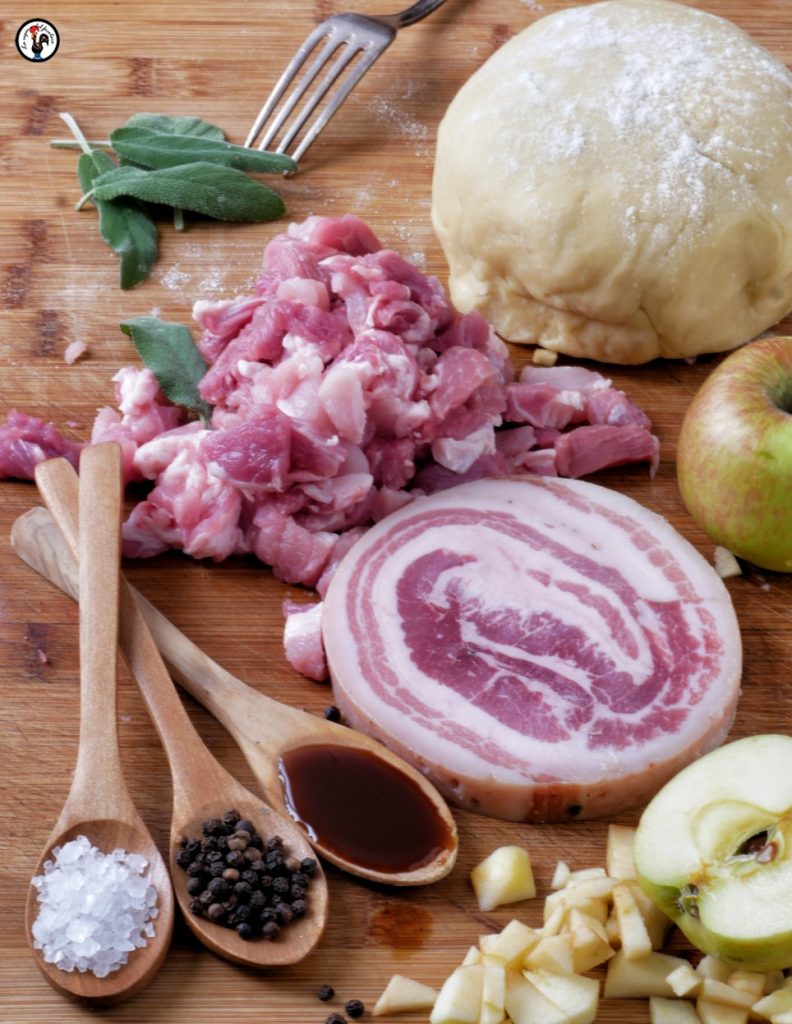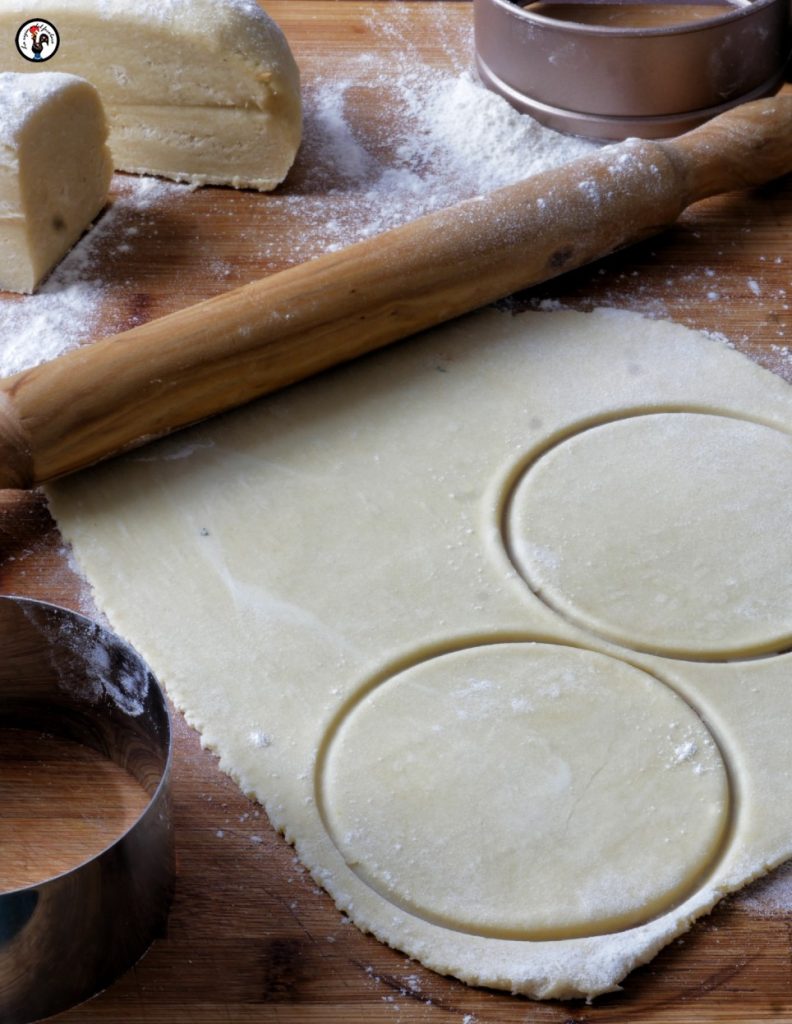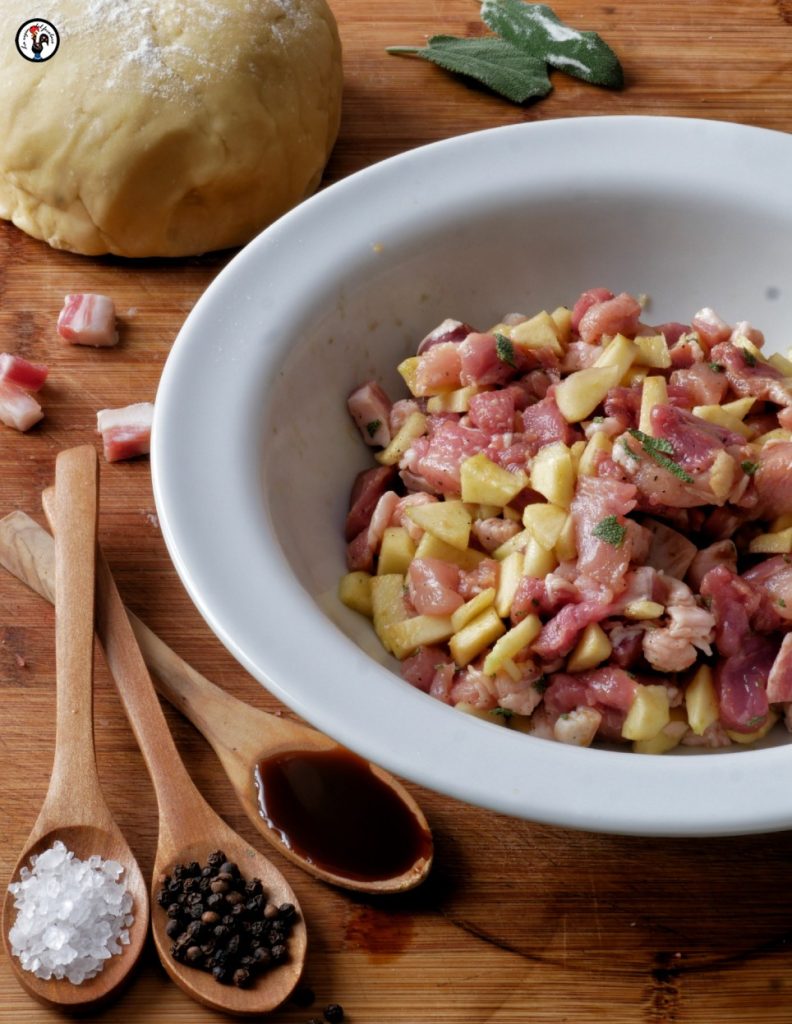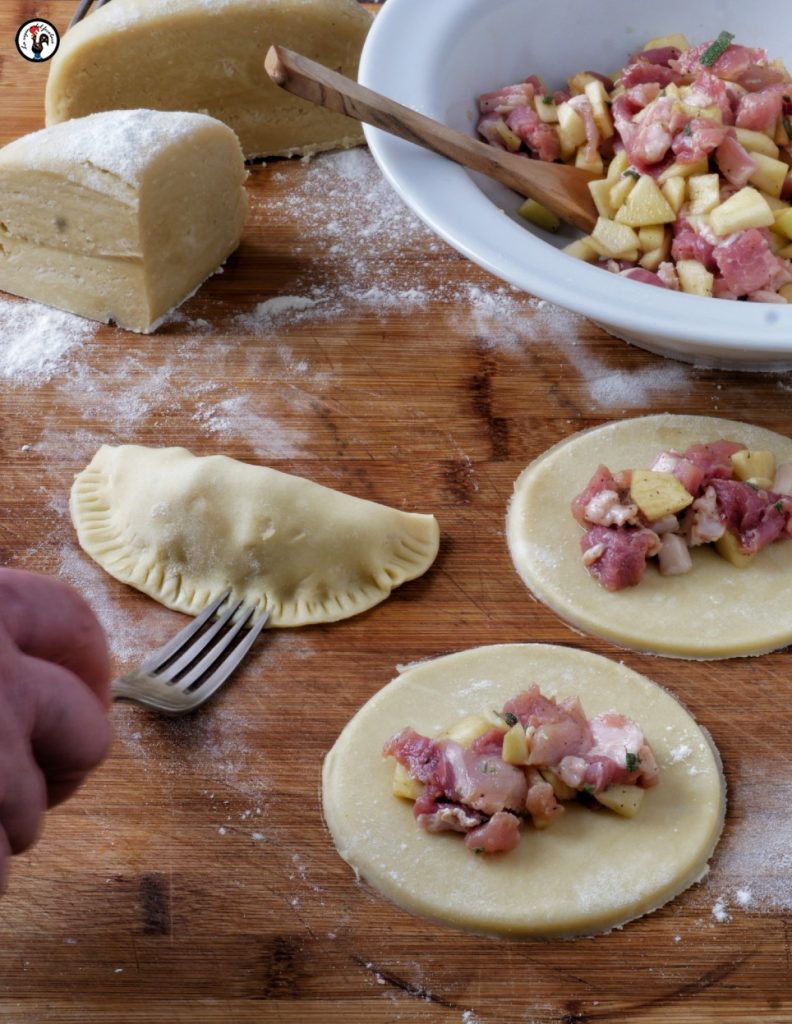The Cornish pasty is the Cornwall Pie, which we are preparing today according to the Downton Abbey recipe, the one from Mrs. Patmore. It is a crescent-shaped shortcrust pastry filled with meat and vegetables and well sealed. It bakes in the oven and is good both hot and cold. We know many fillings, the oldest being meat and vegetables, while more modern versions, like Mrs. Patmore’s, use pork, bacon, and apples. Actually, English pasties lend themselves to many other varieties of filling, even sweet ones with fresh and dried fruit. The Cornish pasty has a very ancient history and, in 2003, it obtained European protection with the PGI mark.

- Difficulty: Easy
- Cost: Inexpensive
- Rest time: 30 Minutes
- Preparation time: 30 Minutes
- Portions: 4
- Cooking methods: Oven
- Cuisine: English
- Seasonality: All seasons
What You Need to Make the Cornish Pasty
- 4 1/3 cups all-purpose flour
- 1 tsp salt
- 7.5 oz butter (or suet)
- as needed water (for kneading)
- 2 Granny Smith apples (small)
- 7 oz pork (specifically shoulder)
- 4 oz bacon (or streaky, but not smoked)
- 1 tbsp Worcestershire sauce (or mushroom ketchup)
- 1 tbsp sage (fresh)
- 1/2 tsp salt
- 1/4 tsp black pepper
Tools
We can knead by hand or get help from a good mixer. For the rest, we will only need:
• a sharp knife
• a rolling pin
• a bowl
• a fork
- 1 Stand Mixer
How to Prepare the Cornish Meat Pie
The pastry shell of the Cornish pasty is a variant of shortcrust pastry. Quickly knead the flour, salt, and butter with your fingertips without warming it. You will get sandy crumbs. Continue kneading with a trickle of water, enough to obtain a soft dough ball. Then transfer the dough to the work surface, knead it quickly again, and let it rest in a cool place covered.
Unfortunately, my trusted organic butcher shop opens only three days a week, otherwise, I would have certainly ordered suet to prepare this dough. In fact, after the period when animal fats like suet (fat surrounding the heart and kidney) and lard were banned, things have changed. Suet is typical of traditional English cuisine, used in many traditional preparations like Christmas Pudding, and today it has made a comeback in European kitchens, thanks to new young chefs. However, it is very important to know where to buy, so I recommend organic or high-quality butcher shops.
If you are interested, you can read this interesting article from Gambero Rosso.

While the dough rests in a cool place, prepare the filling in a bowl.
Dice the pork, bacon, and peeled apples into very small cubes. Mix everything in a large bowl, and season with salt, pepper, and Worcestershire sauce or ketchup. Finish with finely chopped fresh sage, which will add a delightful aroma.
The filling for the Cornish pasty is not pre-cooked but will bake in the oven along with its shell.

Divide the dough in half, and roll out one part on a floured surface until it’s about 0.12 inches thick. Then, using a pastry cutter (or a cup, which will work just as well), cut out 6-inch diameter discs. Place a scant spoonful of filling in the center, after mixing it well. Then fold the dough to form a half-moon. Carefully seal the edges, using the tines of a fork. Repeat the same process with the other half of the dough, then recombine the scraps and roll them out once again to make the last Cornish pasties. However, be careful because this dough, rich in butter, tends to flake if kneaded and rolled several times in succession: so try to cut with accuracy, to have as little waste as possible.
Finally, prick the pastries before putting them in the oven at 375°F for twenty minutes. They should be golden, and the filling should reach a temperature of 165°F to be cooked.

The Downton Abbey Cookbooks
After the success of Downton Abbey, a series I never tire of watching, I bought the cookbooks from the series without hesitation. There are three: the first, from which this recipe is taken, is the Official Downton Abbey Cookbook, which collects all the best recipes of the series, the habits of the family, and those of the downstairs servants. The second is a themed book and talks about Christmas at Downton Abbey, titled Official Downton Abbey Christmas Cookbook. From this book, my recipe for Christmas Pudding is taken. The third beautiful book, small with two different editions, concerns afternoon tea at Downton Abbey. Mine is green and titled Recipes for Afternoon Tea, and it describes tea time in early 20th-century England.
I honestly wouldn’t know which book is the most beautiful; they are a pleasure for the eyes and mind, and the recipes are foolproof. From the official cookbook, I love the cultural snippets “food for thought,” a few lines that sometimes accompany the recipes and tell historical episodes or curiosities. From the Christmas cookbook, the sparkle and elegance enchant me, and from the little book on the tea ritual, I like the care in preparing delicious cakes, beautiful cakes, sandwiches, and savory snacks, among which the Cornish pasties rightly belong.
You can find a review of Downton Abbey cookbooks on the Italian Food Bloggers Association website, curated by the talented Micaela Ferri.
The Queen’s Secrets
This ancient recipe has no secrets in its execution, but it has a long history. In fact, the famous filled pastry is much more than street food; the first notes regarding the Cornish Pasties date back to the 1300s or perhaps even earlier. Henry III, in an edict, asked the population of Great Yarmouth for a large number of herrings, to be sent to him within fifty-four pies. From many other documents, we know that initially, pasties were served in royal canteens and consumed only by the nobility. As they constitute a complete dish, in the following centuries, pasties became the meal of miners working in the copper and tin mines of Cornwall. Easy to carry, consume, and even reheat, they thus spread widely among fishermen and farmers. We know many fillings, both sweet and savory. The oldest, based on vegetables, potatoes, turnips, and meat or fish (if possible), the more recent ones, like those of Mrs. Patmore, based on pork, bacon, and apples.
The PGI Mark
The Cornish Pasty Association in August 2003 obtained European protection status (PGI) for the Cornish Pasty, which means that only pasties made in Cornwall, according to traditional recipes and methods, can legally be called Cornish pasties.
Mrs. Patmore’s, made with apples and pork with sage aroma, are perfect even with tea, but, unfortunately, do not meet the standards…
Finally, there are popular beliefs and legends related to the Cornish Pasty, if you want to discover them, I recommend consulting this article from Gazzetta del gusto, from which I have taken much information.
Do you know where to find me?
Returning to the HOME, you will find many other recipes, both sweet and savory. There are many ideas, sweet and savory recipes, that often have a story to tell. Follow me on Facebook and Instagram, you will find very quick recipes and many useful tips, and you will never run out of ideas for dinner again.
Furthermore, you can receive all the new recipes on the Telegram channel of my blog. It is free, and to subscribe, you just need to open this link: in this way you’ll always be updated on recipes, secrets, tips, and news. You’ll receive all the recipes on your phone, without risking missing any and without needing to enter any phone number or email address; if you ever wish to leave the channel, it will be enough to delete it.
Note: This recipe contains an affiliate link.

